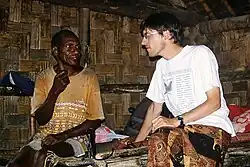| Olrat | |
|---|---|
| Ōlrat | |
| Pronunciation | [ʊlrat] |
| Native to | Vanuatu |
| Region | Gaua |
Native speakers | 3 (2012)[1] |
| Language codes | |
| ISO 639-3 | olr |
| Glottolog | olra1234 |
| ELP | Olrat |
 Olrat is classified as Critically Endangered by the UNESCO Atlas of the World's Languages in Danger | |
Olrat was an Oceanic language of Gaua island, in northern Vanuatu. It became extinct in 2009, with the death of its last speaker Maten Womal.[2]
Name
The name Olrat (spelled natively as Ōlrat [ʊlrat]) is an endonym. Robert Codrington mentions a place south of Lakon village under the Mota name Ulrata.[3] A few decades later, Sidney Ray mentions the language briefly in 1926 under the same Mota name ‒ but provides no linguistic information.[4]
The language
In 2003, only three speakers of Olrat remained, who lived on the middle-west coast of Gaua.[5] Their community had left their inland hamlet of Olrat in the first half of the 20th century, and merged into the larger village of Jōlap where Lakon is dominant.[1][2]
Alexandre François identifies Olrat as a distinct language from its immediate neighbor Lakon, on phonological,[6] grammatical,[7] and lexical[8] grounds.
Phonology
Olrat has 14 phonemic vowels. These include 7 short /i ɪ ɛ a ɔ ʊ u/ and 7 long vowels /iː ɪː ɛː aː ɔː ʊː uː/.[9][2]
| Front | Back | |
|---|---|---|
| Near-close | i ⟨i⟩ ∙ iː ⟨ii⟩ | u ⟨u⟩ ∙ uː ⟨uu⟩ |
| Close-mid | ɪ ⟨ē⟩ ∙ ɪː ⟨ēē⟩ | ʊ ⟨ō⟩ ∙ ʊː ⟨ōō⟩ |
| Open-mid | ɛ ⟨e⟩ ∙ ɛː ⟨ee⟩ | ɔ ⟨o⟩ ∙ ɔː ⟨oo⟩ |
| Open | a ⟨a⟩ ∙ aː ⟨aa⟩ | |
Historically, the phonologization of vowel length originates in the compensatory lengthening of short vowels when the voiced velar fricative /ɣ/ was lost syllable-finally.[10]
Grammar
The system of personal pronouns in Olrat contrasts clusivity, and distinguishes four numbers (singular, dual, trial, plural).[11]
Spatial reference in Olrat is based on a system of geocentric (absolute) directionals, which is typical of Oceanic languages.[12]
Notes and references
References
- 1 2 François (2012).
- 1 2 3 François (2022).
- ↑ See page 378 of: Codrington, R. H. (1885). The Melanesian Languages. Vol. 47. Oxford: Clarendon Press. pp. 25–60.
- ↑ See page 428 of: Ray, Sidney Herbert (1926). A Comparative Study of the Melanesian Island Languages. Cambridge: Cambridge University Press. pp. xvi+598. ISBN 9781107682023. .
- ↑ List of Banks islands languages.
- ↑ François (2005)
- ↑ François (2007)
- ↑ François (2011)
- ↑ François (2005:445), François (2011:194).
- ↑ François (2005:461).
- ↑ François (2016).
- ↑ François (2015).
Bibliography
- François, Alexandre (2005), "Unraveling the history of the vowels of seventeen northern Vanuatu languages" (PDF), Oceanic Linguistics, 44 (2): 443–504, doi:10.1353/ol.2005.0034, S2CID 131668754
- —— (2007), "Noun articles in Torres and Banks languages: Conservation and innovation" (PDF), in Siegel, Jeff; Lynch, John; Eades, Diana (eds.), Language Description, History and Development: Linguistic indulgence in memory of Terry Crowley, Creole Language Library 30, Amsterdam: Benjamins, pp. 313–326
- —— (2011), "Social ecology and language history in the northern Vanuatu linkage: A tale of divergence and convergence" (PDF), Journal of Historical Linguistics, 1 (2): 175–246, doi:10.1075/jhl.1.2.03fra, hdl:1885/29283, S2CID 42217419.
- —— (2012), "The dynamics of linguistic diversity: Egalitarian multilingualism and power imbalance among northern Vanuatu languages" (PDF), International Journal of the Sociology of Language, 2012 (214): 85–110, doi:10.1515/ijsl-2012-0022, S2CID 145208588
- —— (2015). "The ins and outs of up and down: Disentangling the nine geocentric space systems of Torres and Banks languages" (PDF). In Alexandre François; Sébastien Lacrampe; Michael Franjieh; Stefan Schnell (eds.). The languages of Vanuatu: Unity and diversity. Studies in the Languages of Island Melanesia. Canberra: Asia-Pacific Linguistics. pp. 137–195. hdl:1885/14819. ISBN 978-1-922185-23-5.
- —— (2016), "The historical morphology of personal pronouns in northern Vanuatu" (PDF), in Pozdniakov, Konstantin (ed.), Comparatisme et reconstruction : tendances actuelles, Faits de Langues, vol. 47, Bern: Peter Lang, pp. 25–60
- —— (2022). "Presentation of the Olrat language and audio archive". Pangloss Collection. Paris: CNRS. Retrieved 29 Sep 2022.
